We asked Opta’s Dutch and South American data editors to give us the key stories ahead of the World Cup 2022 Netherlands vs. Argentina quarter-final at the Lusail Iconic Stadium on Friday. This is the Face Off.
Netherlands
Joost Berger, Thomas Markhorst, Wesley Mak
Total Football is a Thing of the Past
Daley & Denzel
Double Trouble
Argentina
Antonio Maza, Matias Conde
Netherlands… Again
Two Sides of the Same Coin
Messi, De Paul and the Defence: Three Pillars of Argentina
Make four predictions on Netherlands vs. Argentina to win $500
You must allow functional cookies to continue.
Netherlands
Total Football is a Thing of the Past
The current Dutch team are far away from the ‘Total Football’ machine of the past. Just like at the 2010 and 2014 World Cup tournaments – where they finished second and third respectively – results are the main priority to coach Louis van Gaal, with their well-known style of the past now fully abandoned.
Whilst possession and dominance of the ball were key elements of the Netherlands’ past World Cup teams, the last three tournaments that they’ve qualified for have seen a different ethos – but it’s produced results, so far.
When they reached the semi-finals in 2014, the Dutch averaged 49.6% possession – the first time that they’d averaged less than their opponents at a World Cup, but it produced results. This was the same four years earlier, when they reached the final in South Africa, only to lose very late on in extra time against possession-hungry Spain.
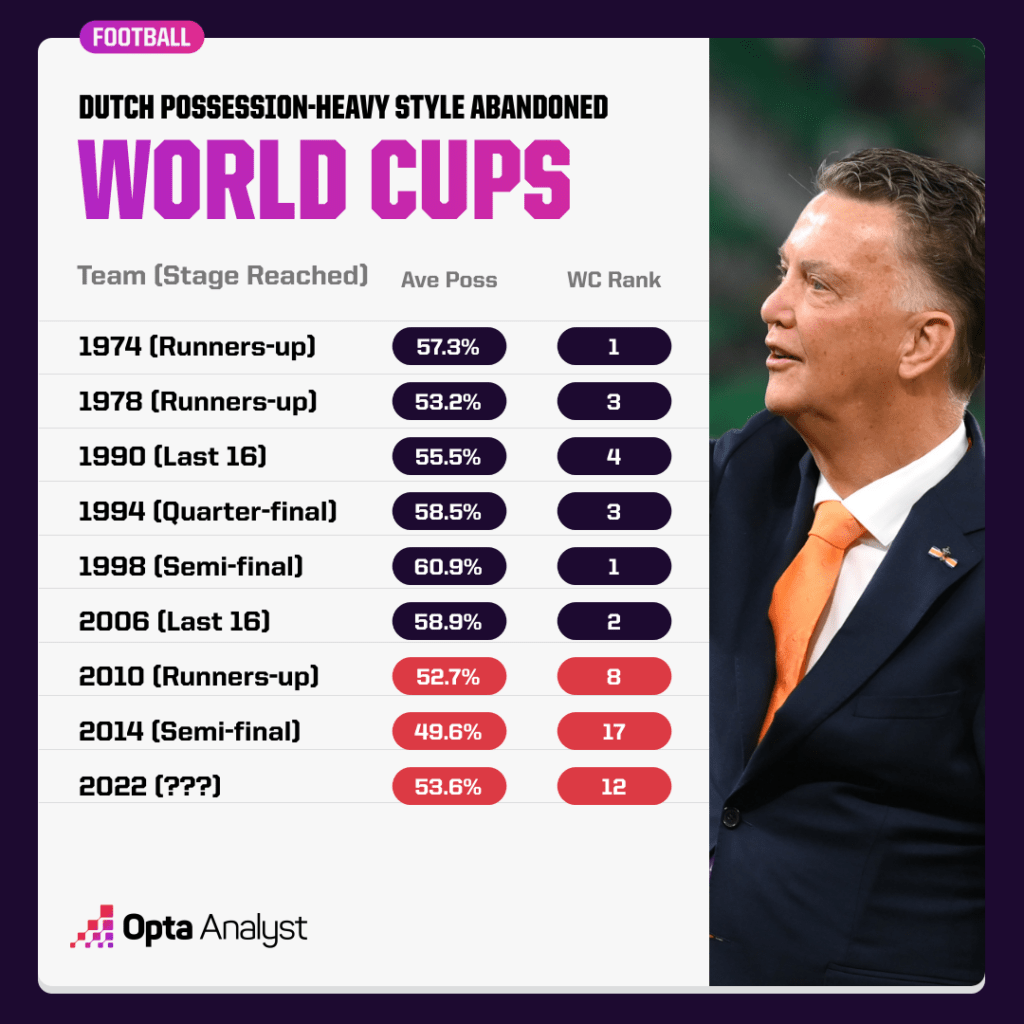
One statistic that will worry the Dutch is their propensity to allow opponents to steal the ball high up the pitch and trouble their goal.
The Netherlands have conceded a high turnover within 40 metres of their own goal on 31 occasions at this World Cup, but 10 of these have led to opposition shots – the highest total of any team at the 2022 tournament.
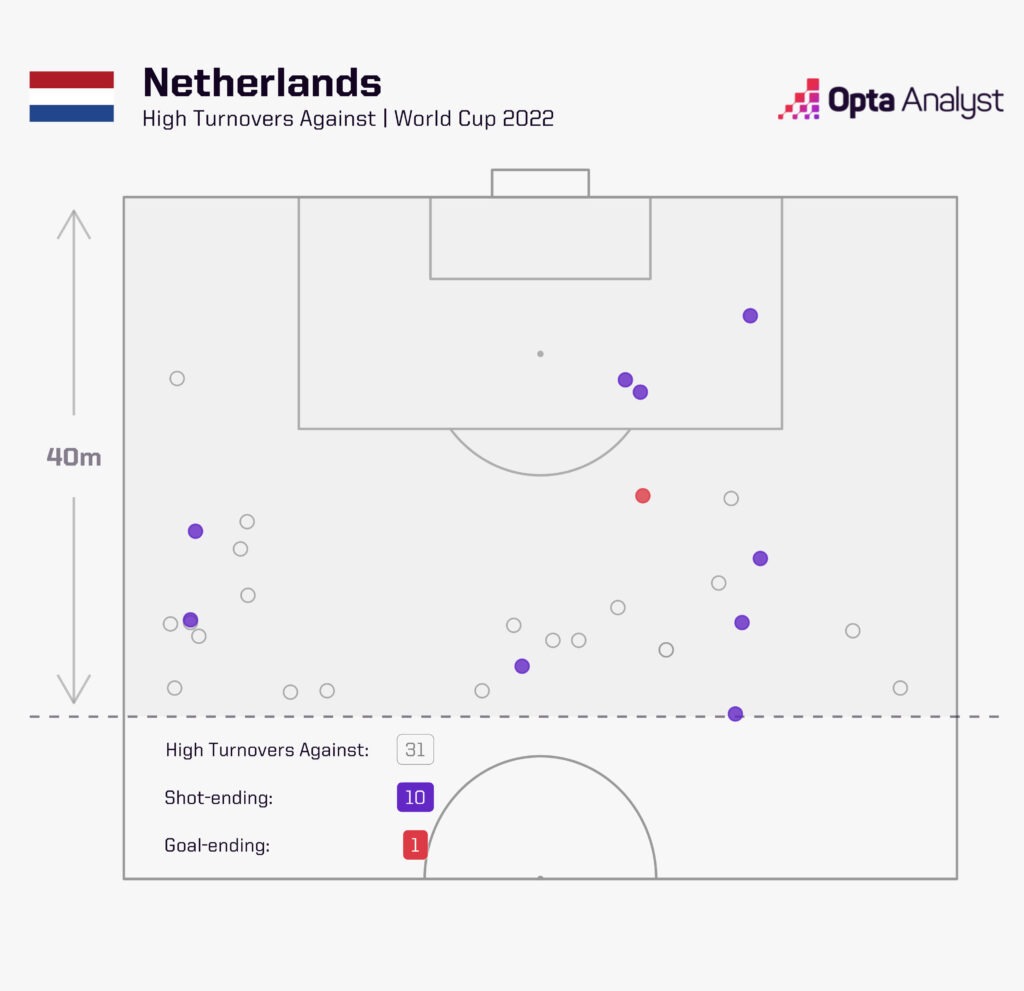
The experienced Van Gaal was also the Netherlands’ coach during the 2014 tournament and at the age of 71 years and 123 days old on the day of this match, he’s the third-oldest coach to take charge of a World Cup game. Should they win this tie, he’ll overtake Uruguayan Óscar Tabárez (71y 125d) to become second oldest in the ranking in the semi-finals.
Being aware of having a decent squad, but definitely not the highest sum of qualities of players among all sides, he’s decided to play a 3-4-1-2 formation just like eight years ago. Van Gaal’s tactical decisions have allowed opponents much of the ball in order to potentially hurt them with a counter-attack. Consequently, four of the five World Cup games with the lowest possession rate of Netherlands on record (since 1966) have been under his management, with three of them in 2014 and the other one in this year’s round of 16 match against the United States (41.6%).
But there is little doubt that the popular coach deserves the compliments. His record at World Cups is outstanding. No man has coached as many World Cup games without a defeat (excluding penalty shootouts) than he has (11 games – W8 D3 L0). If the Netherlands avoid an outright defeat before any potential penalty shootout on Friday versus Argentina, Van Gaal will equal the record of Brazilian Luiz Felipe Scolari by going unbeaten in his first 12 World Cup games. Penalties are a sore point versus Argentina, however – they exited the 2014 World Cup at the semi-finals against the South Americans.
Daley & Denzel
Neither Daley Blind nor Dunzel Dumfries had displayed their full capabilities at this World Cup going into the knockout match versus the United States last weekend. However, they arrived just when the Dutch needed them, in a 3-1 win over the energetic Americans.
32-year-old Blind has lost his undisputed status and starting spot at club side Ajax in the weeks leading up to this tournament, with many critics accusing him of having become too slow for the modern game.
In his three group stage games, Dumfries – the Dutch’ standout player at Euro 2020 with his incisive attacking play and frequent cut-back passes – lost possession on 51 occasions and failed to record a single shot, chance created or find a single team-mate with a cross in the group stage.
However, facing an attack-minded USA side brought the best out in the wing-back pairing.
Blind was everywhere. He scored a goal, assisted another, and didn’t neglect his defensive duties either. With his assist, he joined Dennis Bergkamp as the leading creator of goals in World Cup history for the Dutch (four).
At 32 years & 269 days old, Daley Blind was the oldest Dutch player on the pitch against the USA.
— Opta Analyst (@OptaAnalyst) December 3, 2022
A goal, an assist, a match-high 9 duels won and he made more tackles than any other player (7).
Showing all the kids how it’s done. 🇳🇱 #FIFAWorldCup pic.twitter.com/ZLpsAkul10
Dumfries did what he does so well: going forward and taking ad`vantage of the spaces left by his direct opponent. After a marvellous build-up attack consisting of 20 uninterrupted passes – the highest for a Dutch WC goal in recorded history, Dumfries’ pull-back cross found Memphis Depay for the Dutch opening goal.
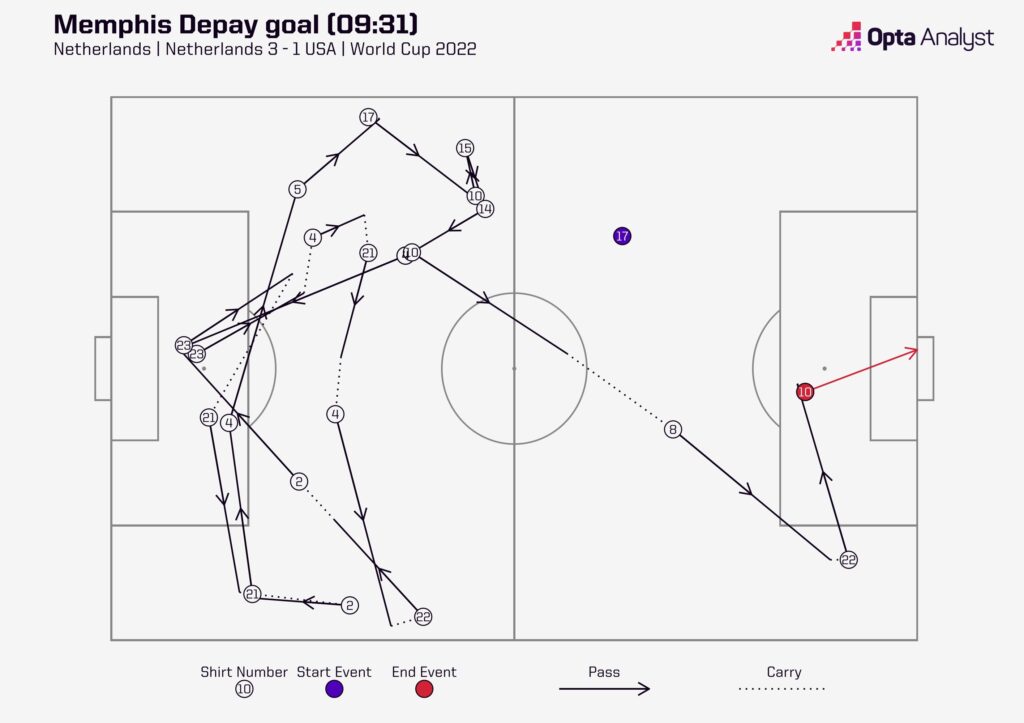
At the end of the first half, the Netherlands simply pressed copy-paste: Dumfries got into space behind enemy lines, pulled back the ball and saw Daley Blind score the 2-0.
With those two assists, Dumfries became the first player to ever assist twice in the first half of a World Cup game for the Dutch, while with his goal in the second half, he was just the third different player to have a hand in at least three goals in a World Cup match for the Netherlands after the great Johan Cruyff and Rob Rensenbrink (twice).
Only England’s Luke Shaw has as many tournament goal involvements as the Dutchman of all European players since the start of Euro 2022 (five). The Argentines should expect more of the same in this quarter-final tie.
Dutch centre backs watching their team attack pic.twitter.com/MhAjbdt56Z
— Average Striker (@AverageStriker) December 3, 2022
Double Trouble
Ahead of the 2022 World Cup, there were serious concerns about the fitness of Memphis Depay. The 28-year-old has played just 131 minutes of competitive football for club side Barcelona in 2022-23 and the feeling was that any other player in this position would have been left out of van Gaal’s squad altogether. But this is Memphis.
With 19 goal involvements in his 12 games for the Netherlands prior to the tournament (14 goals, five assists), there was little chance the Dutch coach was going to leave him at home if there was any chance that he could find some fitness later in the tournament.
But the Dutch had another trick up their sleeve. Cody Gakpo.
Gakpo has already been involved in a ludicrous 30 goals at club level with PSV Eindhoven leading up to the World Cup (13 goals, 17 assists), and he continued his great club form at international level in the Netherlands’ group stage campaign in Qatar.
He scored in all three group stage games – one with his left foot, one with his right and the other with his head. Each of those three were the first goal of the game, meaning he became just the second player in World Cup history to open the scoring in all three group stage matches in a single edition after Italian Alessandro Altobelli in 1986.
Gakpo’s been the most creative player for the Dutch, too. His nine chances created are more than double any other Netherlands player at the tournament so far, with a team-high five of those coming from open play.
Memphis started this tournament with two substitute appearances, before starting in their third group game against Qatar and then the last 16 tie with the USA. Despite playing only 222 minutes, he’s been the leading Dutch player for attacking sequence involvements at the tournament so far (15), which was also the case in their qualifiers for these finals (122), where he led every other player in the UEFA qualification region by 44.
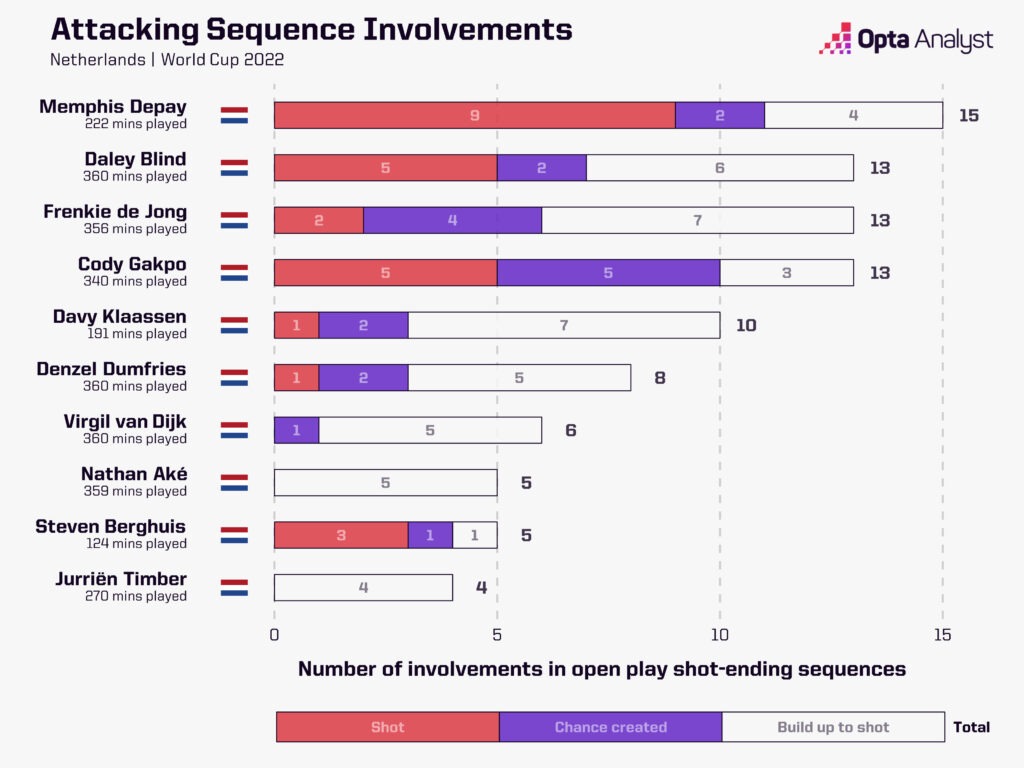
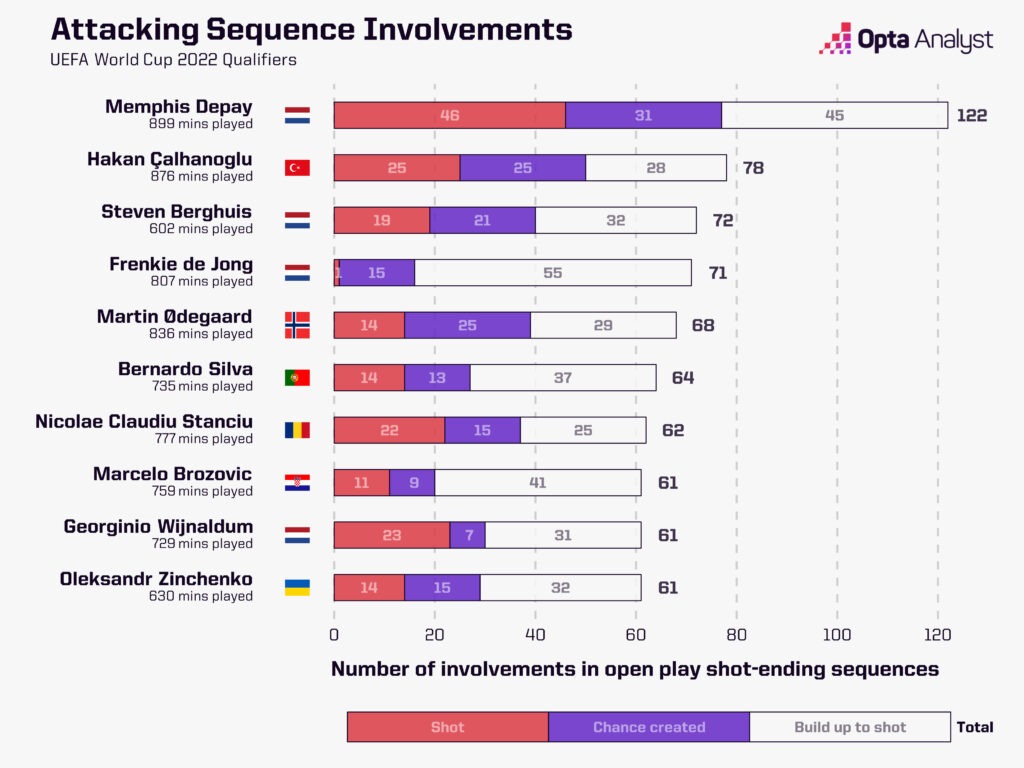
Gakpo and Memphis are two players that can undoubtedly trouble an Argentina defence that hasn’t truly been tested against top-class opposition yet at the World Cup.
Their last World Cup hero against Argentina was Dennis Bergkamp at the same stage of the 1998 tournament. It’s time for another Dutch player to step up and secure hero status.
Argentina
Netherlands… Again
This will be the sixth World Cup meeting between Netherlands and Argentina, with only Brazil against Sweden (seven) and Argentina against Germany (seven) being played more often in the competition.
Although the Argentineans have won only one of those games, their memories against the Dutch couldn’t be better. That sole victory earned them the World Cup title in the 1978 final. One of the two draws they had against the Dutch also counts as an eventual victory, as the Albiceleste progressed to the final in 2014 after a penalty shootout win (0-0 aet).
Two Sides of the Same Coin
Argentina won their most recent title, and the first one after 28 years of waiting, in the 2021 Copa América, defeating Brazil 1-0 in the decisive match. During that tournament, Lionel Scaloni’s team averaged only 49.7% of possession, registering just one game with more time on the ball than their opponents: against unfancied Bolivia (67.5%).
At the 2022 World Cup so far, Argentina have shown something different than in that last continental tournament, with higher amounts of possession, although not always with the best of outcomes. Up to the quarter-finals, La Albiceleste are the second ranked team in possession (65.3%) and passes per possession (8.9), behind Spain in both aspects (76.5% and 10.5 respectively).
Some similarities with Luis Enrique’s Spain can be identified: Argentina had some trouble when it comes to open the scoring, despite their dominance in terms of possession. In all four of the games they have played at Qatar 2022, Scaloni’s team had more than 60% of dominance of the ball by half time, but only scoring twice in the opening 45 minutes.
The exception was Poland, where they were able to translate that territorial and possession dominance into danger to the opposition, shooting 12 times and accumulating 2.0 xG, while in their other three games they haven’t able to attempt more than five in the first half of the match.
A showcase of this was their must-win second group game against Mexico, with only one shot (0.08 xG) coming during the first period of the game and again in the round of 16 meeting against Australia (one shot, 0.04 xG, up to Messi’s goal in the 35th minute). It takes time for this Argentina team to get into their flow and break the opposition down – despite averaging 63% possession in the first half of matches at the tournament.
Once Argentina find the first goal, the team starts to show a more dynamic, fluid attack. With the sole exception of their shock opening game defeat against Saudi Arabia, Argentina have been more dangerous once they go ahead and seemingly feel less pressure.
The advantage in terms of goals scored doesn’t translate to an increase of possession to Argentina (a trend of modern football), going from 68.5% to 61.9% when ahead, but the team looks more cohesive and the fluidity of passes is far more evident – their passing accuracy in the final third goes up, from 80.2% to 89.6% when in a positive game state.
The only time that Argentina have fallen behind at this tournament was the occasion we saw the most panic from them. Understandable, perhaps, considering the team came into the tournament on a near-world record 36-game unbeaten run and had almost forgotten what it was like to be in a losing position.
After Saudi Arabia took the lead in their opening game against Argentina in the 53rd minute, Argentina’s passing accuracy (81.5%) and passing accuracy in the final third (74.6%) dropped far below the team’s average in the tournament (88% and 83.4%).
During Lionel Scaloni’s tenure as Argentina coach, the Albiceleste have found themselves behind in games on just 10 occasions, and before their opening match against the Saudis in this tournament, the last time they found themselves in a losing position was in November of 2021, when they drew 2-2 against Paraguay in the World Cup Qualifiers. In fact, they been able to come from behind to win a game under Scaloni only once – a 2-1 win in Bolivia back in October 2020 in the CONMEBOL qualifiers for this tournament.
Messi, De Paul and the Defence: Three Pillars of Argentina
It was Lionel Messi who had the key to unlock the gates when Argentina have struggled to impose their style on to games so far at this tournament, and with trademark goals: Against México, a ling range shot with a value of only 0.02 xG and against Australia in the last round, with a classic right-to-centre move followed by a low finish through a crowded box (0.04xG).
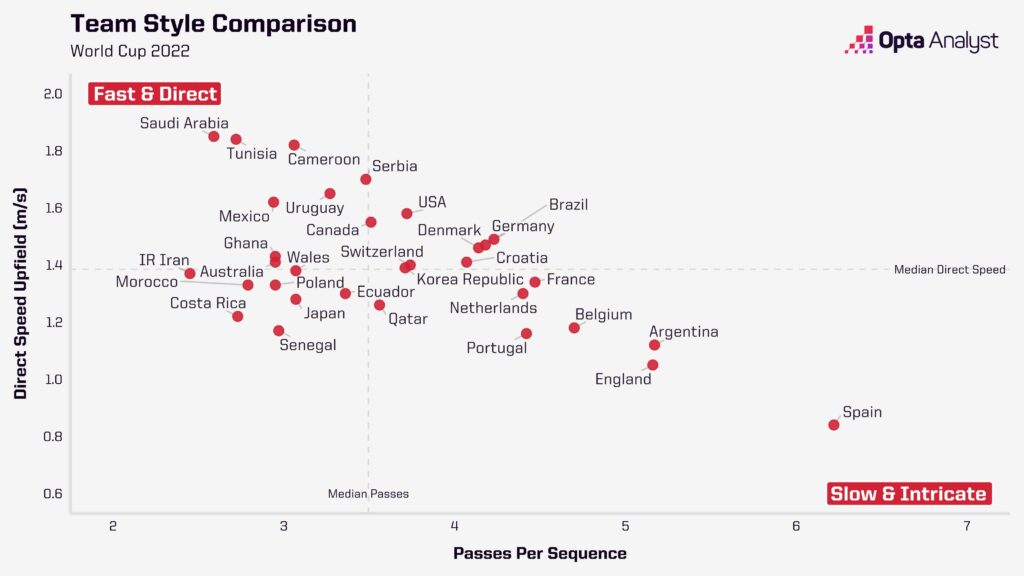
The style of play of Argentina is not that different to what Spain has shown, with long sequences of passes and a more intricate way of moving the ball, and you have to imagine Argentina’s coach took some lessons from Spain’s elimination by the hands of Morocco when it comes to possession.
If Argentina can’t find a way towards the Dutch goal, monopolizing the ball, while Louis van Gaal’s team trying to counterpress and launch counter-attacks, Scaloni always has that trick up his sleeve for the worst-case scenario, the world’s greatest player, who can turn the match upside down – something that Spain evidently didn’t have at this World Cup.
The other main part of the Argentine puzzle is Rodrigo De Paul. Following critical opinions by the media and fans alike after a poor, erratic showing against Saudi Arabia, the man nicknamed “little engine” or “Motorcito” in Spanish by his team-mates, has displayed better form in the subsequent three games.
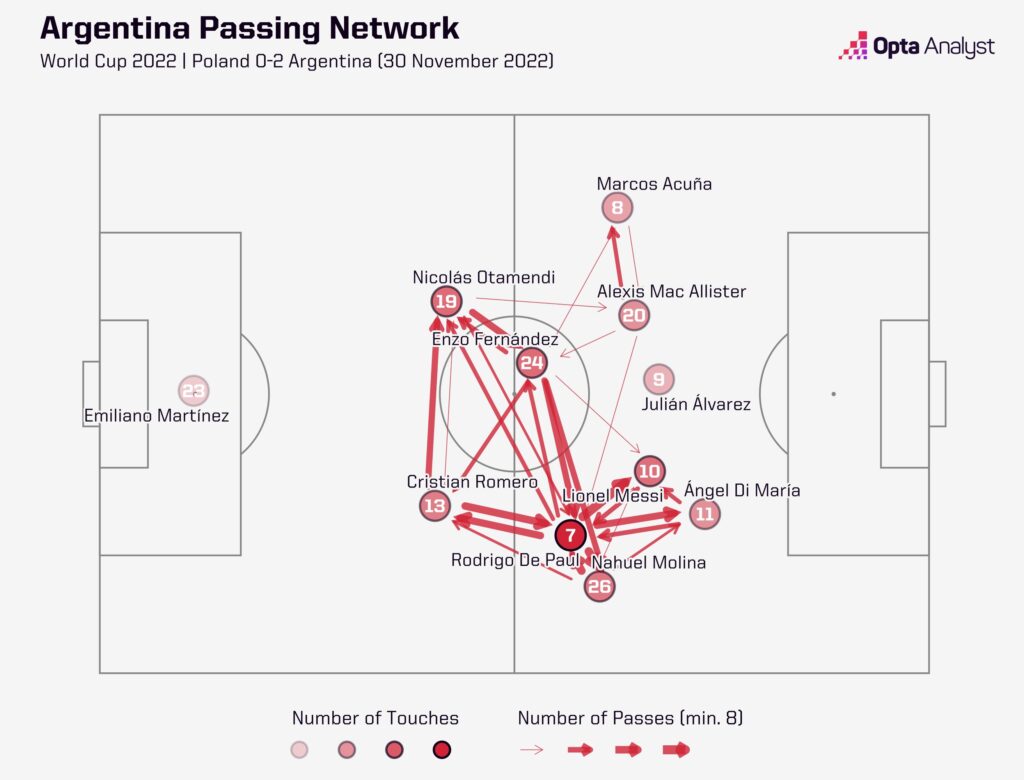
De Paul is the player with the most touches per game (113.3) and successful passes per game (95, with 87% accuracy) in Argentina’s 2022 World Cup squad. De Paul is also a key element in defence, with 7.3 recoveries and 1.8 tackles per game. Nonetheless, his best role in the team is to be the support for Lionel Messi: this is the most frequent link in the team, as shown in the second half against both Poland (19 passes between the two) and Australia (11 passes between the two), which coincided with moments of higher threat by Argentina in these matches (1.70 and 1.62 xG).
With rumours that De Paul may be sidelined for this quarter-final against the Netherlands, it could be time for Enzo Fernández, Leandro Paredes or Guido Rodríguez to step up and find that same kind of connection, both on the pitch and on the mental side, filling for the Atlético Madrid midfielder.
Despite only allowing three goals in four matches – including an own goal against Australia – the Argentinian defence has been one of the high points during the World Cup, with the lowest average of shots and shots on target conceded (4.0 and 1.0), expected goals against (0.3 xG) and the second lowest xGOT against (0.5), which are far superior to the Netherlands’ defensive numbers – the Dutch average 13 shots and 1.0 xG against per game at this tournament.
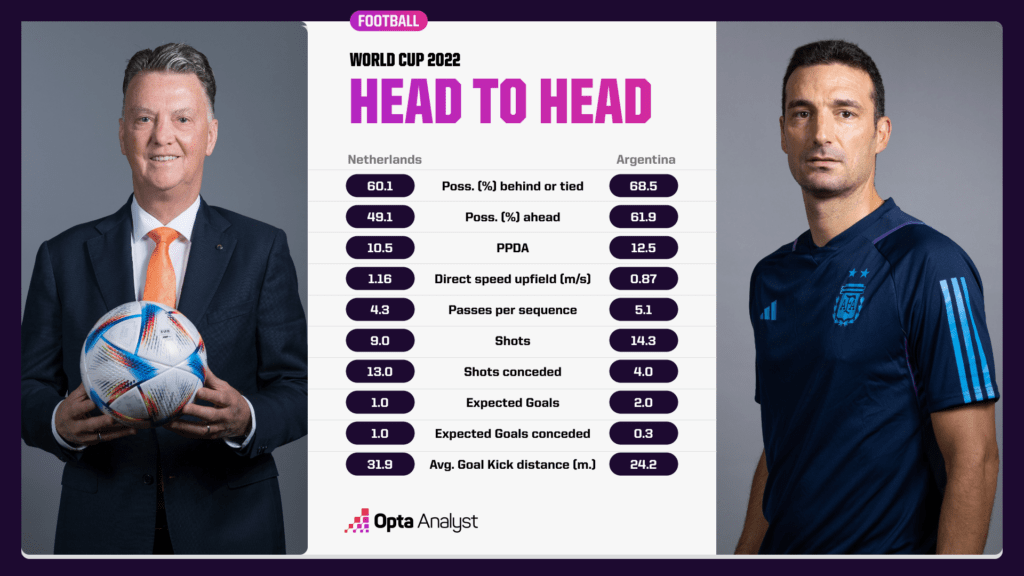
This level of defensive solidity has been sustained despite a heavy rotation in the back line, with Nicolás Otamendi as the sole player from the defensive roster to be ever-present so far. Centre-backs (Romero and Lisandro Martínez) and full-backs (Acuña, Tagliafico, Montiel and Molina) have all seen minutes at the tournament but have also alternated starting berths. This is not a strange move by Scaloni, who has rotated heavily during his time in charge of Argentina, with only one defensive player yet to see minutes at Qatar 2022 (Juan Foyth).
